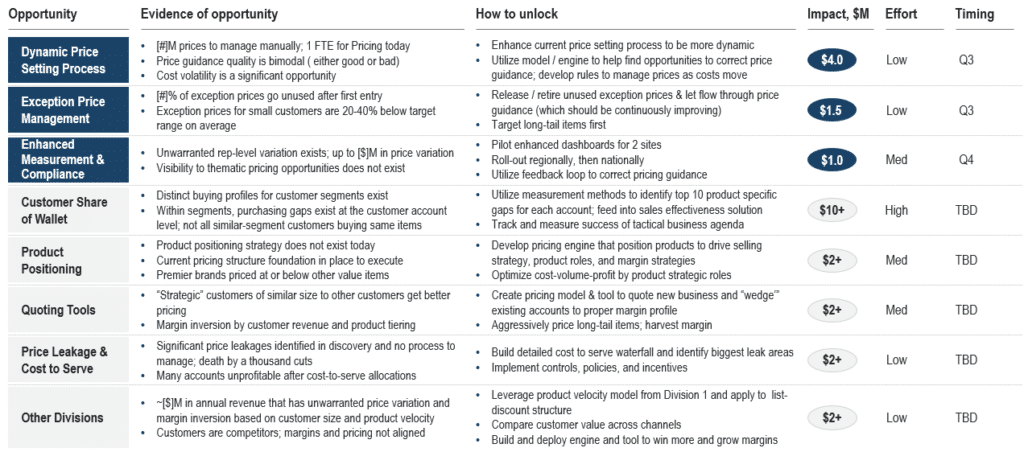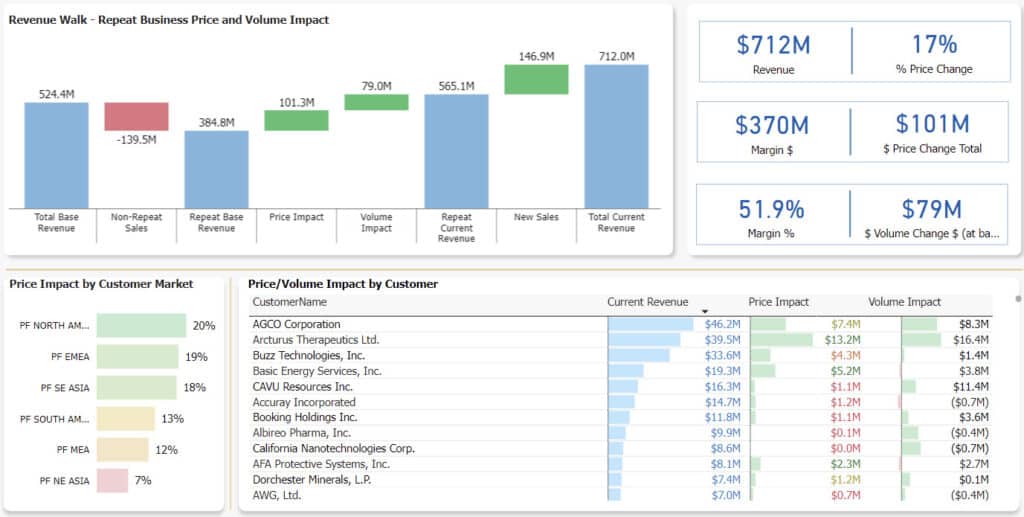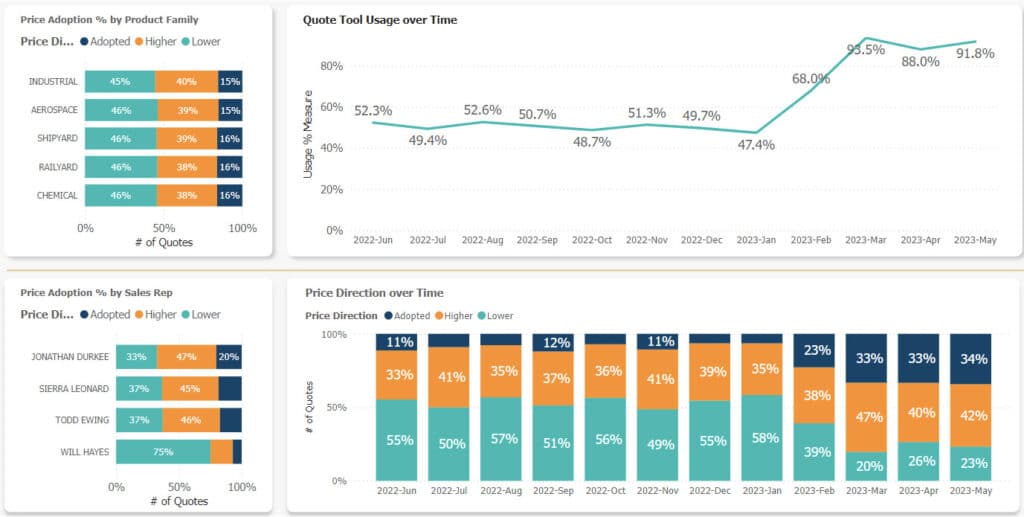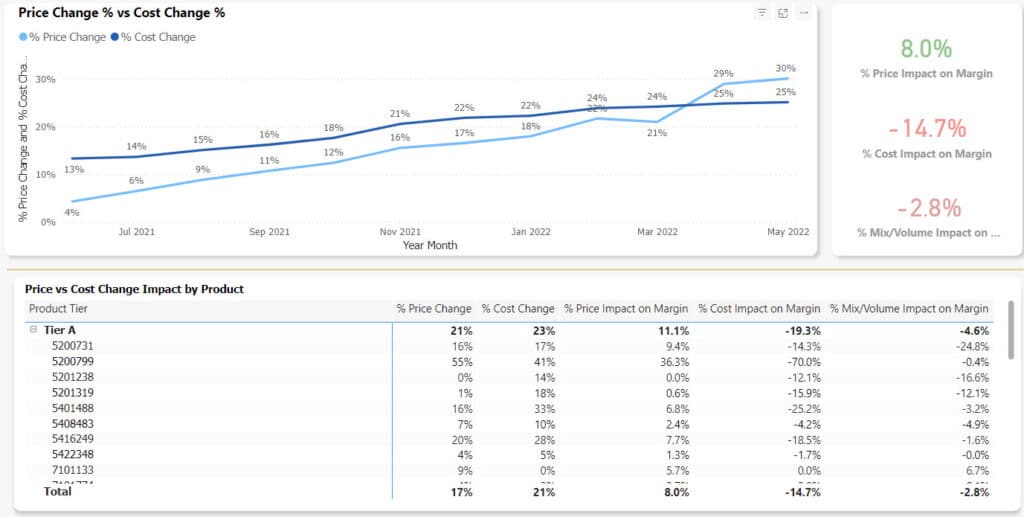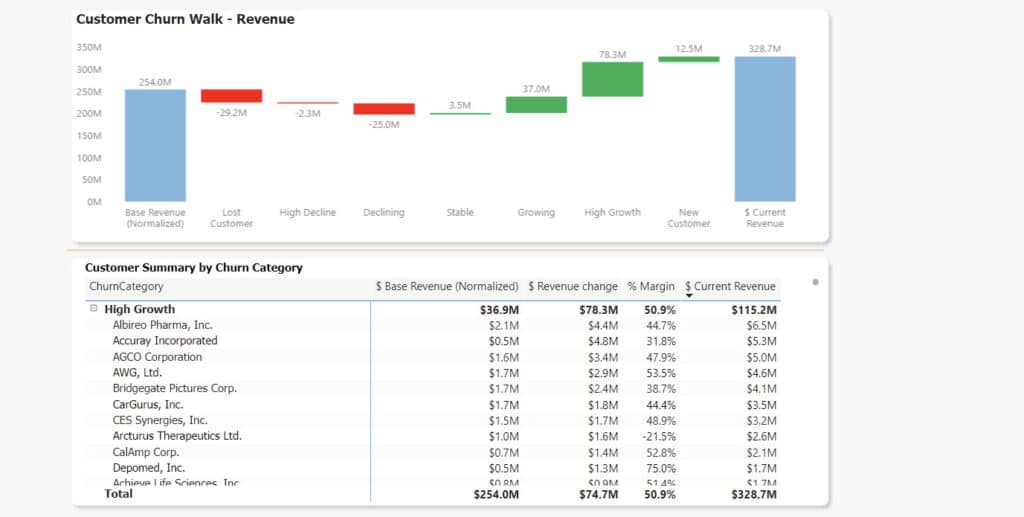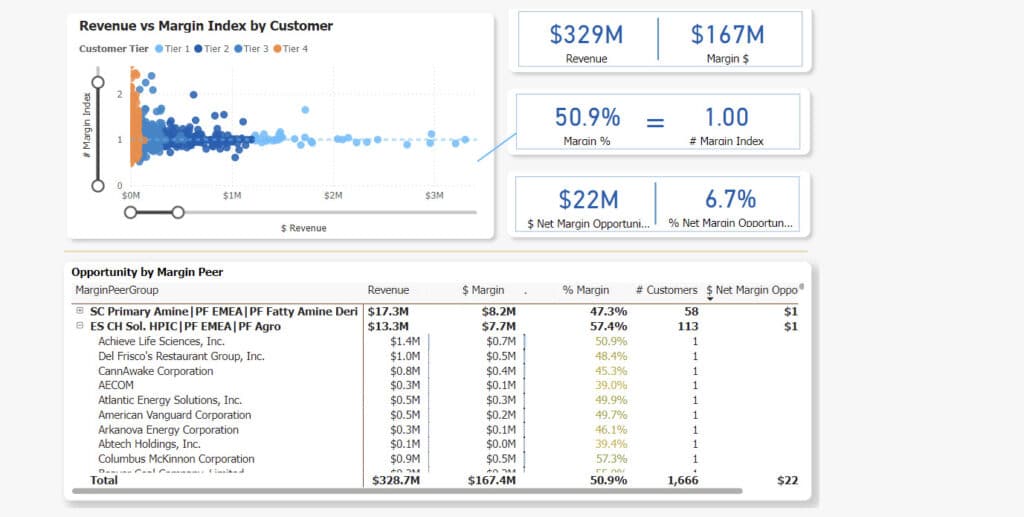How Pricing Analytics Drives Sustainable Growth in Your Pricing Strategy

In the dynamic landscape of today’s business world, pricing is more than just a number on a tag; it’s a strategic lever that can significantly impact a company’s profitability and growth trajectory. Yet, many businesses struggle to harness the full power of pricing due to a lack of robust analytics. Many of our clients have struggled with questions such as:
- Where is my pricing strategy falling short?
- Where can I adjust pricing to drive revenue and margin?
- How are price and volume affecting margin?
- Am I pricing too high for my customers? Am I pricing too low?
- Is my sales team using provided pricing?
- What else can I do to drive growth?
In this article, we’ll explore the key challenges organizations face in utilizing analytics for pricing excellence, highlight a set of valuable pricing analyses that drive profitable decision-making, and offer insights into how to best utilize pricing analytics to answer critical business questions and build effective pricing strategies.
Why Pricing Analytics Matter: Avoiding the Pitfalls
While the potential benefits of pricing analytics are substantial, several challenges often hinder businesses from fully leveraging their power.
- Understanding Current Pricing Strategy Effectiveness: One of the primary challenges businesses encounter is determining the success of their current pricing strategies. While most companies can track basic KPIs around revenue, volume, and margin growth, many lack the necessary data and tools to granularly measure and parse out how each pricing action—list prices, discounting, rebates, promotions, quotes, changes in cost versus price—has affected growth by factors such as region, channel, product, customer, or salesperson. With robust price analytics, companies can better understand pricing strategy optimization and the drivers of performance. Without this visibility, it’s difficult to gauge the overall impact of pricing on the bottom line and identify where improvement is needed.
- Identifying Gaps in Your Pricing Strategy: Even with basic pricing analytics, businesses may struggle to pinpoint specific gaps or weaknesses in their existing strategies. This could include poor price adherence causing price variation, failing to account for market sensitivity, or not adequately addressing cost considerations.
- Pinpointing Areas of Underperformance: Another common challenge is identifying where pricing is not driving the expected growth. This requires a deeper dive into data to analyze factors like mix shifts between price and volume, customer churn rates, and sales team adherence to system pricing. Without this granular level of analysis, businesses risk leaving money on the table or inadvertently driving customers away.
- Maintaining an Opportunity Roadmap: Pricing is not a one-time event; it’s an ongoing process that requires continuous monitoring and adjustment. Businesses need to establish and maintain a pricing opportunity roadmap that outlines areas for potential growth and improvement. This requires businesses to continuously measure results in order to identify, prioritize, and execute data-driven adjustments and sustainable growth strategies to their pricing strategy that support long-term growth.
- Managing Messy Data and Unclear Performance: Perhaps the most significant hurdle to effective pricing analytics is the lack of granular data and sophisticated measurement tools. Many businesses are dealing with messy data across disparate systems that impede their ability to produce accurate, reliable, and timely performance metrics. Additionally, companies that rely on outdated systems and spreadsheets are ill-equipped to handle the complexity of best-in-class pricing strategies. Without access to real-time data and advanced analytics capabilities, it’s nearly impossible to gain the insights needed to make informed pricing decisions.
The Key to Success: The Critical Importance of Getting Pricing Analytics Right
The challenges outlined above highlight the critical role that pricing analytics play in achieving pricing excellence. When leveraged effectively, analytics can empower businesses to:
- Optimize Current Pricing Strategies: By providing a clear understanding of current pricing performance, price analysis enables businesses to identify areas to optimize their strategies to maximize profitability. Instead of just setting prices every year, organizations can react to changes in the marketplace and learnings from measurement results quickly to make necessary adjustments.
- Identify Growth Opportunities: Analytics can help uncover hidden opportunities for growth, such as untapped market segments, potential for premium pricing, enhanced sales enablement training, or areas where costs should be monitored to improve margins.
- Enhance Competitiveness: Key metrics such as price realization, customer churn, and quote acceptance provide businesses a clearer picture of customer behavior and preferences. These factors serve as a critical input when deriving competitive pricing strategies that focus on key differentiators and capture greater market share.
- Improve Decision-Making: Data-driven insights from granular, robust analytics enable businesses to make more informed and confident decisions, reducing the reliance on guesswork and intuition while driving more profitable outcomes.
- Drive Profitability: Ultimately, effective pricing analytics can directly contribute to improved profitability and drive revenue growth with analytics by providing all of the above outcomes, which in turn can maximize revenue and optimize margins.
5 Valuable Pricing Analyses for Data-Driven Pricing Decisions
- Price Volume Mix Analysis
Price impact versus volume impact on revenue or margin with ability to drill into specific markets, regions, channels, customers, or products.
- Price Adherence
View commercial team usage of system pricing and customer adoption of pricing.
- Price Change vs Cost Change
View historical changes in price versus changes in cost to see where cost has outpaced price. Ability to view price, cost, and volume impact on margin by products, customers, region, and other factors.
- Customer Churn Walk – by Revenue
A categorization of customers by their change in revenue.
- Margin Indices
A comparison of actual margin percent for a given transaction versus a benchmark comprised of comparable transactions.
Additional valuable pricing analyses:
- Price Realization: Calculate the actual price received compared to the list price or quote.
- Customer and Product Tiering: Group customers and products based on their overall contribution to revenue.
- Cost to Serve Waterfall: Calculate every addition and subtraction from your gross revenue that lead to net margin in order to identify price leaks.
- Actual vs Contracted Revenue: Calculate deviations from expected sales from contracted revenue.
- Elasticity of Demand Analysis: Measure how price changes affect customer demand to identify optimal pricing for maximizing revenue without losing customers.
- Competitive Pricing Analysis: Benchmark your prices against competitors to ensure your pricing remains competitive without sacrificing profitability.
- Additional beneficial Pricing Analyses can be found in our article: Top 7 Pricing Analyses to Optimize Your Pricing Strategies
Overcoming Common Challenges in Using Pricing Analytics for Growth
To harness the power of analytics for pricing excellence, businesses must overcome the obstacles that stand in their way. Here are some key strategies:
- Invest in the Right Pricing Technology: Modern pricing strategies demand modern pricing technology. Businesses should consider investing in dedicated pricing software or upgrading their existing systems to enable granular data collection, close to real-time analysis, and sophisticated modeling capabilities that allow for ongoing adjustments to your pricing.
- Develop a Data-Driven Culture: Implementing new systems, technologies, and processes without properly training and supporting the users can result in huge gaps in expected outcomes. Organizations should invest in a culture where data is valued and used to inform pricing decisions. This involves training teams on decision-support analysis and technologies, fostering collaboration between different departments, and ensuring data is readily accessible.
- Embrace Continuous Improvement: Pricing is not a static process; it requires ongoing monitoring and adjustment. Organizations that adopt a mindset of continuous improvement will hold a significant advantage. Regularly reviewing the performance of your pricing strategy and making timely data-driven adjustments will empower these businesses to optimize performance at a much higher rate than those that do not.
- Seek External Pricing Expertise: If internal resources are limited or a business needs to act quickly, consider partnering with a pricing consultant. These experts can provide valuable guidance and support in developing and implementing effective price performance analytics that inform profitable pricing strategies.
Pricing Analytics with INSIGHT2PROFIT
In today’s competitive landscape, robust pricing analytics is no longer a luxury; it’s a necessity for businesses seeking to thrive. By overcoming the challenges associated with data collection, analysis, and implementation, organizations can unlock the full potential of pricing to drive profitability, implement sustainable growth strategies, and achieve long-term success.
Remember, the key lies in embracing a data-driven approach, investing in the right technologies and expertise, and fostering a culture of continuous improvement. With the right strategy and commitment, businesses can transform pricing from a guessing game into a powerful engine for success.
If you have unanswered questions about your pricing, INSIGHT can help develop a data-driven pricing strategy that helps you meet your growth goals. Contact us to learn how our combination of strategy, implementation, and technology make us the ideal price consulting partner to help your business drive revenue, grow EBITDA, and optimize ROI.
